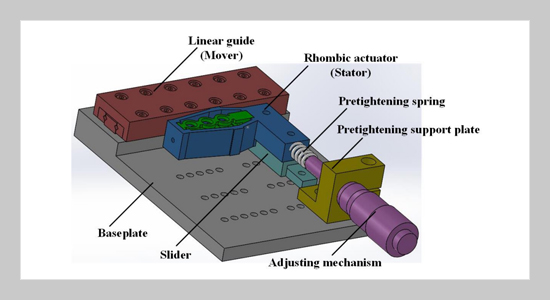Qian Lu 1, Xifu Chen1, Weiqing Huang2
1School of Mechanical Engineering, Yancheng Institute of Technology, Yancheng City, Jiangsu Province, 224051, China
2School of Mechanical and Electric Engineering, Guangzhou University, Guangzhou, 510006, China
Received:
June 24, 2019
Accepted:
March 23, 2020
Publication Date:
September 1, 2020
Download Citation:
||https://doi.org/10.6180/jase.202009_23(3).0004
ABSTRACT
In order to solve the contradiction between high precision and large working stroke in the traditional parallel stage, a novel rhombic piezoelectric actuator was developed. The stator mechanism and the pre-tightening mechanism were proposed, and its working principle was also discussed in detail. The five key structure parameters were optimized based on sensitivity analysis. The experiment results show that the positioning resolution of the rhombic piezoelectric actuator is 0.05 μm, and its continuous motion speed is 1.899 mm/s. The synchronization and the repeatability are also proved by experiments. Finally, the proposed rhombic piezoelectric actuator was applied in a new topology of parallel precision positioning stage. The performance data show that the precision positioning stage has excellent resolution and working stroke. All of the fundamental research contents have a very important theoretical value and experiment foundation for further study of the precision positioning stage.
Keywords:
Piezoelectric Actuator; High Resolution; Large Working Stroke; Parallel Precision Stage
REFERENCES
- [1] Tian, Y., Shirinzadeh B., Zhang, D., “A flexure-based mechanism and control methodology for ultra-precision turning operation,” Precision Engineering, Vol. 33, No. 2, pp. 160-166 (2009).
- [2] Lee, J. W., Li, Y. C., “Design and control of a cascaded piezoelectric actuated two degrees of freedom positioning compliant stage,” Precision Engineering, Vol. 45, No. 4, pp. 374-386 (2016).
- [3] Arakelian, V., Sargsyan, S., “On the design of serial manipulators with decoupled dynamics,” Mechatronics, Vol. 22, No. 6, pp. 904-909 (2012).
- [4] Vose, T. H., Turpin, M. H., Dames, P. M., “Modeling, design, and control of 6-DoF flexure-based parallel mechanisms for vibratory manipulation,” Mechanism and Machine Theory, Vol. 64, No. 1-2, pp. 111-130 (2013).
- [5] Wang, R. Z., Zhang, X. M., “A planar 3-DOF nanopositioning platform with large magnification,” Precision Engineering, Vol. 46, No. 5, pp. 221-231 (2016).
- [6] Zhang, D., Gao, Z. Malosio, M., “A novel flexure parallel micromanipulator based on multi-level displacement amplifier with/without symmetrical design,” International Journal of Mechanics and Materials in Design, Vol. 8, No. 4, pp. 311-325 (2012).
- [7] Schotborgh, W. O., Kokkeler, F. G. M., “Dimensionless design graphs for flexure elements and a comparison between three flexure elements,” Precision Engineering, Vol. 29, No. 1, pp. 41-47 (2005).
- [8] Zelenika, S., Munteanu, M. G., “Optimized flexural hinge shapes for microsystems and high-precision applications,” Mechanism and Machine Theory, Vol. 44, No. 10, pp. 1826-1839 (2009).
- [9] Ma, H. W., Yao, S. M., Wang, L. Q., “Analysis of the displacement amplification ratio of bridge-type flexure hinge,” Sensors and Actuators A: Physical, Vol. 132, No. 2, pp. 730-736 (2006).
- [10] Chih, J. L., Lin, P. T., “Particle swarm optimization based feedforward controller for a XY PZT positioning stage,” Mechatronics, Vol. 22, No. 5, pp. 614-628 (2012).
- [11] Jokiel, B., Ziegert, J. C., Bieg, L., “Uncertainty propagation in calibration of parallel kinematic machines,” Precision Engineering, Vol. 25, No. 1, pp. 48-55 (2001).
- [12] Gallardo, A. J., Rodriguez, C. R., Aguilar, C. R., “A novel six-degrees-of-freedom series-parallel manipulator,” Journal of Mechanical Science and Technology, Vol. 26, No. 6, pp. 1901-1909 (2012).
- [13] Wang, D., Fan, R., “Design and nonlinear analysis of a 6-DOF compliant parallel manipulator with spatial beam flexure hinges,” Precision Engineering, Vol. 45, No. 4, pp. 365-373 (2016).
- [14] Behrouz, A. F., Andersson, A., “Dynamic isotropy in 6-DOF kinematically constrained platforms by three elastic nodal joints,” Precision Engineering, Vol. 45, No. 4, pp. 342-358 (2016).
- [15] Jabbal, M., Jeyalingam, J., “Towards the noise reduction of piezoelectrical-driven synthetic jet actuators,” Sensors and Actuators A: Physical, Vol. 266, No. 10, pp. 273-284 (2017).
- [16] Chen, S. Y., Lee, C. Y., “Compensatory fuzzy neural network control with dynamic parameters estimation for linear voice coil actuator,” Precision Engineering, Vol. 48, No. 2, pp. 191-202 (2017).
- [17] Olfatnia, M., Cui, L. Q., Chopra, P., “Large range dual-axis micro-stage driven by electrostatic comb-drive actuators,” Journal of Micromechanics and Microengineering, Vol. 23, No. 10, pp. 5008-5018 (2013).
- [18] Xu, Q. S., “Design and testing of a novel multi-stroke micropositioning system with variable resolutions,” Review of Scientific Instruments, Vol. 85, No. 2, pp. 5002-5013 (2014).
- [19] Dabbagh, V., Sarhan, A. A. D., Akbari, J., “Design and experimental evaluation of a precise and compact tubular ultrasonic motor driven by a single-phase source,” Precision Engineering, Vol. 48, No. 2, pp. 172-180 (2017).
- [20] Scuor, N., Gallina, P., “Design and testing of a 5-degrees-of-freedom, large working range micropositioning stage,” Robotics and Autonomous Systems, Vol. 60, No. 4, pp. 620-627 (2012).
- [21] Shan, M. C., Ma, S. Y., Xie, H., “Vertical Axis Precision Positioning System Based on Ultrasonic Linear Motor,” Micromotors, Vol. 46, No. 10, pp. 41-43, 60 (2013).
- [22] Lu, Q., Cui, Z., Chen, X., “Fuzzy Multi-objective Optimization for Movement Performance of Deep-notch Elliptical Flexure Hinges,” Review of Scientific Instrument, Vol. 86, No. 6, pp. 065005 (2015).
- [23] Kim, J. J., Choi, Y. M., Ahn, D., “A millimeter-range flexure-based nano-positioning stage using a self-guided displacement amplification mechanism,” Mechanism and Machine Theory, Vol. 50, No. 2, pp. 109-120 (2012)









